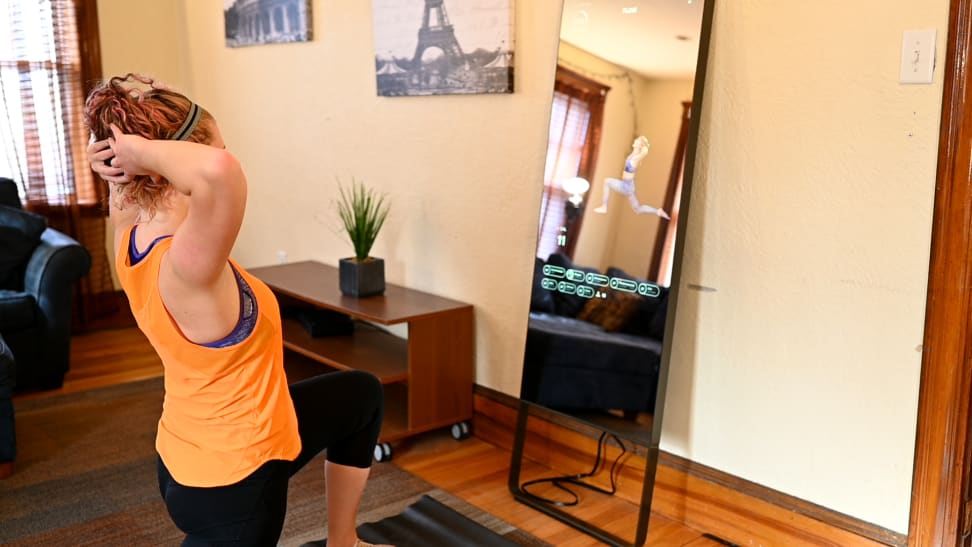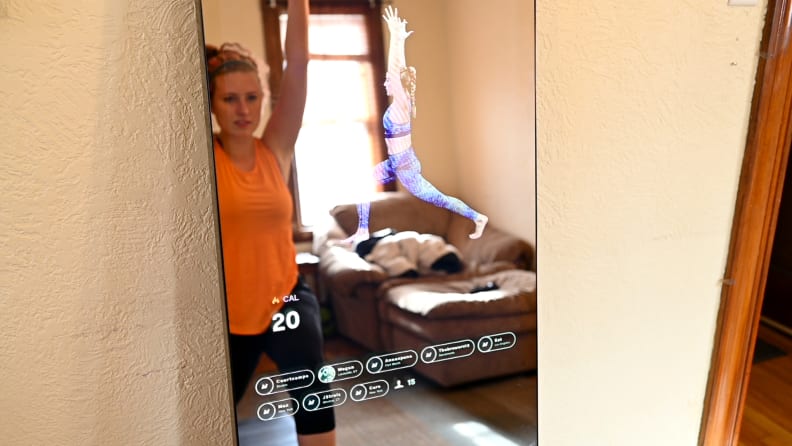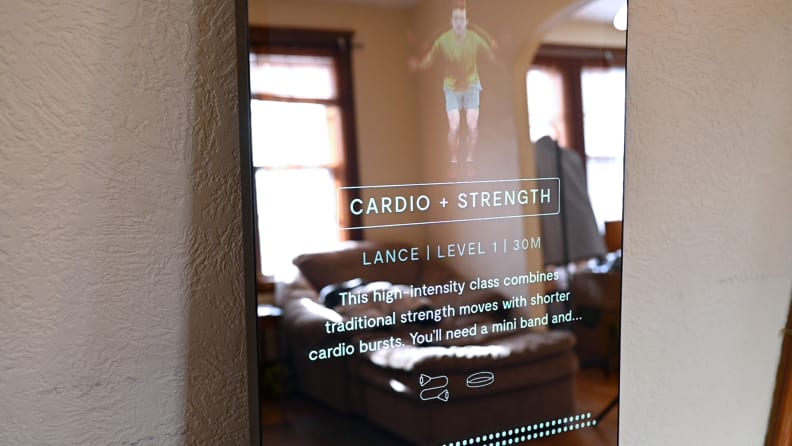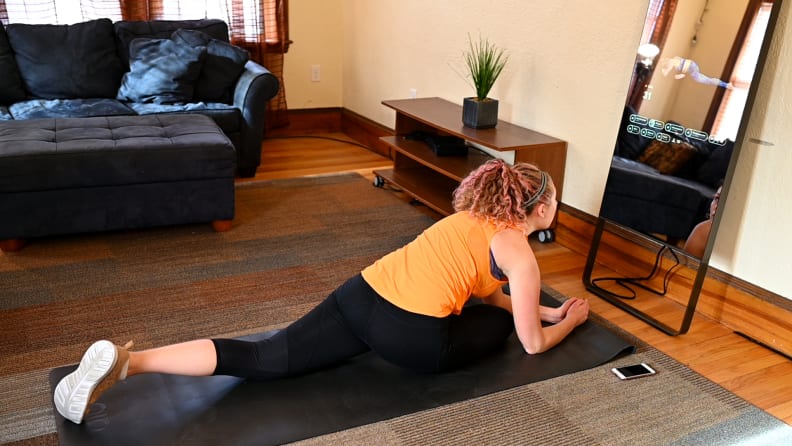If you're a yoga or barre buff, you'll love The Mirror
The original connected smart mirror excels at bodyweight workouts.
 Credit:
Reviewed / Jackson Ruckar
Credit:
Reviewed / Jackson Ruckar
Products are chosen independently by our editors. Purchases made through our links may earn us a commission.
Looking for a way to level up your home workouts? Perhaps you’ve heard of the Mirror, a fitness device that looks like a regular decorative mirror but allows you to stream exercise classes on its hidden screen. Though the first of the connected workout mirrors out there, the Mirror now competes with other devices from Tempo, Tonal, NordicTrack, and more for a spot in your living room. Can the Mirror hold its own? If you’re especially drawn to bodyweight workouts like yoga and barre, we think so.
Editor's Note: Lululemon announced in fall 2023 it was discontinuing production of the Mirror. Current Mirror owner's can continue to take classes, which will now be produced by Peloton, thanks to a deal between Lululemon and Peloton. For other workout mirror recommendations, check out the Best Workout Mirrors.
What is the Mirror?

The Mirror shows various stats on the screen as well as other members taking the class.
You may have seen it flooding your Instagram—the Mirror is the smart workout mirror that started the whole craze. At first glance, it looks like any ordinary full-length mirror. But when powered on, you can stream workouts on the Mirror’s hidden screen and follow along with your workout of choice. When exercising with the Mirror, you can see yourself in the reflection and correct your form to match that of your instructor’s if needed.
From the extensive workout library, you can select among yoga, strength training, cardio kickboxing classes, and more, and filter by difficulty level, equipment used, and impact level (e.g. “ground only,” “up to down,” “no jumping”). The Mirror’s 10,000-plus sessions range from 5 to 60 minutes, and you can choose from prerecorded or daily live classes, in which you can interact with other participants and your instructor. You can choose your soundtrack from the Mirror’s playlists such as pop, rock, and “throwback” for each class, or you can connect to Apple Music and swap out the tunes if you don’t love what the Mirror has selected.
In addition, the Mirror offers one-on-one personal training sessions, which cost $40 a pop. We didn’t take any virtual training sessions so cannot speak to the experience, but it’s a nice feature for those who want more individualized training from home.
During your workout, the Mirror shows how many estimated calories you’re burning (though you can turn this feature off), and you can connect a heart rate monitor via Bluetooth to see those stats as well.
How much does the Mirror cost?

This high-tech mirror comes with a hefty price tag.
On its own, the Mirror costs $1,495—this includes the device itself, a stand should you choose not to mount it on the wall, and a lens cap to cover the camera when not in use. At the time of writing the price is down to $795, which excludes a $39 monthly Lululemon Studio subscription. You can create up to six profiles with one account, and enjoy workout classes from Lululemon Studio partners like Rumble, Y7, Dogpound, and Pure Barre. Should you want to enjoy any of the partner classes IRL, Studio members receive 20% off in-person classes.
Though not mandatory, you’ll probably want some accessories to use during your workouts. You can purchase a bundle of Lululemon accessories—the company owns the Mirror—with one of the offered package deals, or receive a 10% discount on Lululemon gear as part of your Studio membership.
The Mirror Essentials package includes a branded heart rate monitor, resistance bands, a Lululemon The Reversible Mat 5mm, a Lululemon mat strap, a Lululemon yoga block, and a Lululemon mini foam roller, and costs $995. The Mirror Pro package includes all of those items and throws in one pair of Mirror weights (you have the option to select one pair ranging from 1 pound to 35 pounds), and a Lululemon workout towel for $1,295. The Mirror Family package includes two of everything except the actual Mirror, stand, lens cap, and mini foam roller, and costs $1,645.
What we like about the Mirror

You can choose from a variety of live and on-demand classes through the Mirror's corresponding app.
The excellent classes and instructors
Every class I took with the Mirror was fun, challenging, and easy to follow. Each instructor brought a unique teaching style to class, and I enjoyed every session. One of the biggest advantages of the Mirror is its ample selection of live classes. The Mirror’s live classes let you interact with others in the class more than any other mirrors we tested. The instructor can see you (so long as you don’t have the lens cap on), cheer you on, and give feedback on your form. Roughly 100 other people typically joined me during the classes I took, though some more popular classes had over 500 participants. Additionally you can interact with others during class by sending out emojis like a smiley face, a fire emoji, or a sweating emoji, and add a note for others to read.
During prerecorded classes you can skip movements or rewind and repeat a set. And when setting up your account, the Mirror asks if you have any injuries or limitations (you can alter your survey answers at any time) and will recommend alternative movements during class if needed.
You can take both live and prerecorded classes on your phone as well, should you want to exercise without the Mirror, say, when traveling.
Its pretty design and reflectivity
The Mirror is arguably the sleekest looking device we tested, with its simple design and frame allowing it to blend into nearly any space. In addition to the fact that it looks like decor, it acts like a true mirror and allows you to see your reflection even when powered on. The Tempo Studio and Tonal, our top two overall performers, both have a digital screen in the place of a true reflective mirror. Both machines use AI to give users form feedback so there is arguably less need to check your own form in the first place, but some users may be more comfortable being able to evaluate themselves throughout their workouts.
What we don’t like about the Mirror

The Mirror isn't great for all types of workouts.
It’s best for bodyweight workouts
My main complaint about the Mirror is that it’s best for bodyweight workouts, which I get sick of after a few weeks until I can find new ways to up the difficulty. Though I enjoy the occasional bodyweight pilates session or yoga flow, I prefer challenging myself with weights, bands, or cable resistance and pushing myself to get stronger. If this is how you like to exercise, you won’t get it with the Mirror.
You can take strength training classes with the Mirror—they’re excellent, don’t get me wrong—and use the Mirror’s dumbbells, but those max out at 35 pounds, which isn’t very heavy in the grand scheme of things. The Mirror’s dumbbells are “smart” and can pair with the Mirror so you can see what weight you’re using, but the 1-pound dumbbells cost $50 and the 35-pound dumbbells cost $200. (For comparison, you can find a 1-pound pair of dumbbells on Amazon for $12 and a 35-pound pair for $80.) For $350, you can buy our favorite set of adjustable dumbbells, the Bowflex SelectTech 552, and get weights from 5 to 52.5 pounds per side in one set.
All this is to say, it’s more difficult and expensive to gain strength with the Mirror. If you want to challenge yourself to lift heavier weights, you’re better off investing in Tonal, another workout mirror that uses resistance cables to let users lift up to 200 pounds (though for a higher price tag than the Mirror).
Its nonexistent storage space
Furthermore, if you purchase accessories to use with the Mirror—dumbbells, resistance bands, ankle weights, and so on—you will need to find your own way to store them. Many other mirrors we tested, including the Tempo Studio, ProForm Vue, and NordicTrack Vault have built-in storage for any equipment you may use, but the Mirror has none.
Should you buy the Mirror?

The Mirror offers classes like yoga, pilates, barre, boxing, and more.
Yes, if you want to take live classes from home and enjoy bodyweight exercises
The main positive of the Mirror is its live classes. It’s fun to interact with others and helpful to get feedback from instructors. I felt the Mirror cultivated an exercise community more than any other device I tested.
However, if you don’t enjoy participating in live classes or aren’t looking for a sense of community when you work out, you may not be able to justify the price tag, despite the Mirror’s excellent classes and instructors. I enjoyed the yoga flows from Alo Moves, our favorite yoga app, just as much as the Mirror’s classes, and an Alo Moves subscription only costs $20 a month. If the high-tech streaming doesn’t impress you, you could take various workout classes in front of a mirror in your bedroom and DIY the experience for a heck of a lot less money.
In the end, if you enjoy bodyweight exercises like pilates, yoga, or barre and are looking to replicate the in-person class experience without leaving your home, the Mirror is the way to go.
